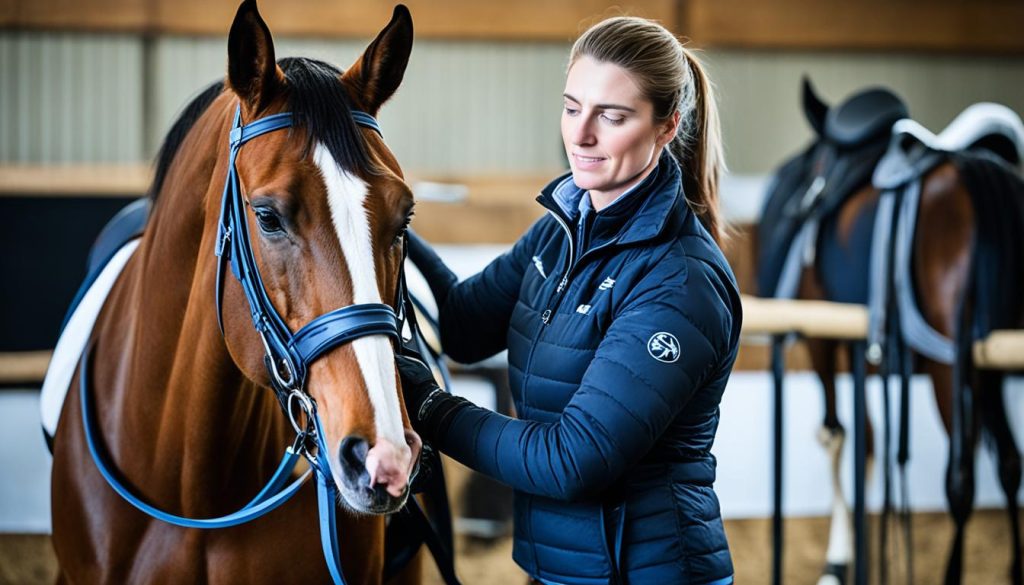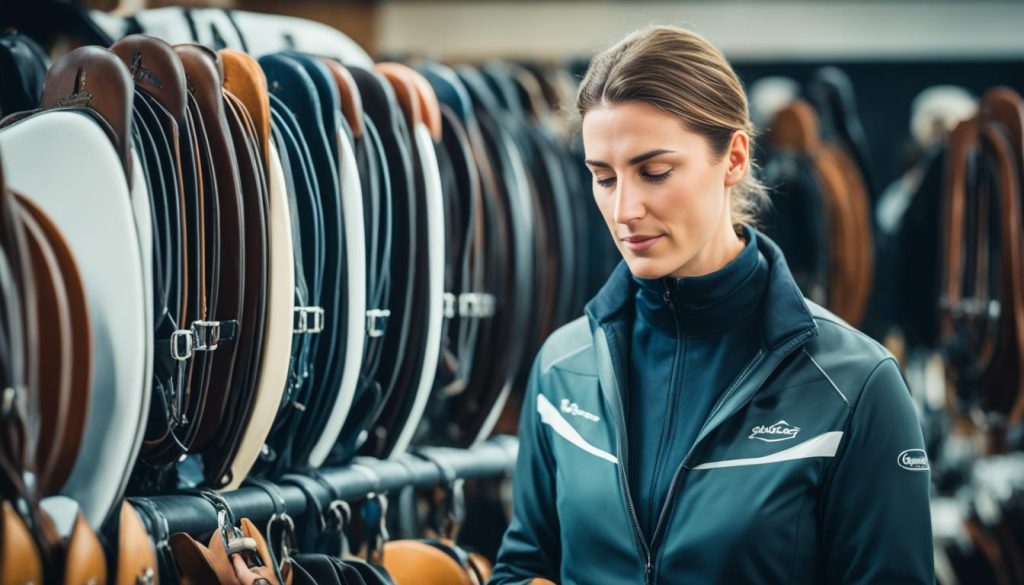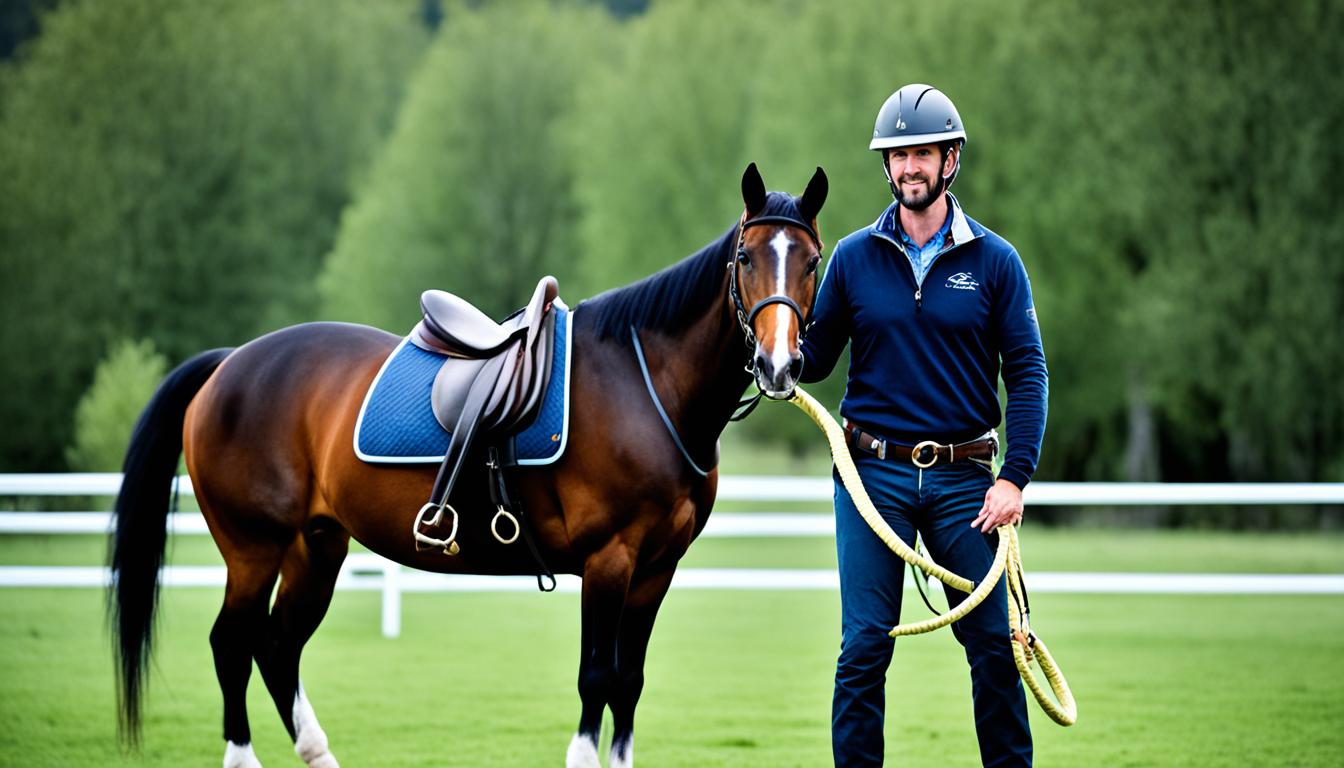Did you know that saddle training is a fundamental aspect of learning to ride a horse? It not only helps you develop the necessary skills for horseback riding but also ensures the safety and comfort of both rider and horse. Whether you’re looking to take horse riding lessons, pursue equestrian training, or simply enhance your knowledge of saddle fitting and horseback riding classes, understanding the basics of saddle training is essential.
In this beginner’s guide, we’ll dive into the world of saddle training, exploring the techniques, tips, and knowledge you need for a successful and fulfilling equestrian journey. From choosing the right saddle to preparing yourself and your horse for training, we’ll cover all the essential aspects to set you up for saddle training success.
Key Takeaways:
- Saddle training is crucial for beginner riders
- Understanding saddle parts and anatomy is important for choosing the right saddle
- Preparing yourself physically and mentally is essential for successful saddle training
- Saddle training builds confidence, effective communication, and control
- By following the guidelines in this guide, you can lay a strong foundation for saddle training success
What is Saddle Training?
Saddle training is an essential process in the development of a horse’s riding career. It involves introducing the horse to wearing and being ridden with a saddle. This training helps horses become familiar with the weight and feel of a saddle, as well as the pressure of a rider’s legs and cues.
Patient and consistent approaches to saddle training are key to ensuring the horse’s comfort and safety throughout the process. Building trust through groundwork is an effective way to establish a strong foundation for successful training. Gradually introducing the saddle and using positive reinforcement to reward desired behaviors can help create a positive association with the equipment.
By implementing proper saddle training techniques, horses can develop the necessary connection and understanding of how to respond to their rider’s cues. This training not only prepares horses for comfortable and controlled riding experiences but also promotes effective communication between rider and horse.

| Benefits of Saddle Training: | Guidelines for Successful Saddle Training: |
|---|---|
|
|
Why is Saddle Training Important for Beginners?
Saddle training is crucial for beginner riders as it serves multiple important purposes. First and foremost, proper saddle training significantly enhances horseback riding safety. By learning how to properly saddle and mount a horse, beginners reduce the risk of accidents or injuries while riding.
Furthermore, saddle training helps beginners develop good balance and posture, which are essential for maintaining stability in the saddle. Through exercises and practice, riders learn to align their bodies correctly and distribute their weight evenly, allowing them to ride with confidence and control.
Effective communication is another crucial aspect of saddle training. Beginners learn how to communicate and direct their horses using reins and leg aids, thereby establishing a strong connection and understanding between horse and rider. This clear and effective communication ensures smooth transitions, precise movements, and overall harmonious riding experiences.
Saddle training also plays a pivotal role in building confidence. As beginners gain experience and proficiency in the saddle, their confidence grows. They become more comfortable handling different situations and challenges that may arise during horseback riding.
Lastly, saddle training enables beginners to exert control over the horse’s speed, direction, and movements. Through proper training techniques, riders learn how to guide their horses with subtle cues, allowing for seamless cooperation and a sense of partnership between horse and rider.
Overall, saddle training is an essential foundation for beginner riders, ensuring their safety, developing proper riding skills, enhancing communication, building confidence, and establishing control. By mastering saddle training, beginners can embark on a successful and enjoyable horseback riding journey.
Choosing the Right Saddle
When it comes to saddle training for beginners, one crucial aspect to focus on is choosing the right saddle. After all, the saddle is a key element in ensuring comfort, safety, and optimal riding performance.
Factors to consider when choosing a saddle include:
- Size and shape of the horse: Every horse has a unique conformation, so it’s important to select a saddle that fits their body correctly. The saddle should allow freedom of movement for the horse’s shoulders and back.
- Riding discipline: Different riding disciplines require specific saddle designs to accommodate the rider’s position and the horse’s movement. Whether you ride dressage, show jumping, or trail riding, choose a saddle that suits your chosen discipline.
- Materials used in the saddle: Saddles can be made from various materials, such as leather, synthetic materials, or a combination of both. Consider the durability, maintenance, and comfort of the saddle materials.
- Seat size: The seat size of the saddle should be appropriate for the rider’s body proportions. A saddle with the correct seat size allows the rider to maintain proper balance and stability in the saddle.
- Budget: Determine your budget for purchasing a saddle. Keep in mind that a well-made saddle designed to fit both horse and rider properly is an investment that will last for years.
- Brand reputation: Research and consider reputable saddle brands known for their quality craftsmanship, comfort, and fit.
A properly fitting saddle is crucial for the comfort and well-being of the horse, as an ill-fitting saddle can cause discomfort, pain, and even injury. Understanding the different parts and anatomy of a saddle will also help in selecting the right one.

| Saddle Fit Considerations | Effect on Horse and Rider |
|---|---|
| Saddle too narrow | Can cause pinching, pressure points, and discomfort for the horse. Rider’s weight is not evenly distributed, causing imbalance and potential pain. |
| Saddle too wide | Can lead to rocking and sliding of the saddle, causing discomfort and potential back soreness for the horse. The rider may struggle to maintain proper balance and stability. |
| Incorrect gullet size | The gullet should provide adequate clearance for the horse’s spine. An incorrect gullet size can cause pressure on the spine, leading to pain and potential long-term damage. |
| Poorly positioned stirrups | The stirrup bars should be positioned correctly to allow the rider’s legs to hang naturally. Incorrect stirrup position can affect the rider’s balance and leg position. |
Understanding Saddle Parts and Anatomy
When it comes to choosing the right saddle, it’s essential to have a good understanding of the various parts and anatomy of a saddle. Each component plays a crucial role in ensuring comfort, balance, and effective communication between the rider and the horse.
Saddle Tree
The saddle tree forms the framework of the saddle. It provides stability and support, distributing the rider’s weight evenly across the horse’s back. A well-designed tree is essential for a comfortable and secure fit.
Seat
The seat is the part of the saddle that the rider sits on. It should be cushioned and contoured to provide comfort and support during long rides. A properly fitting seat helps maintain the rider’s balance and stability.
Gullet
The gullet is the channel that runs along the length of the saddle and provides clearance for the horse’s spine. It prevents pressure and discomfort, ensuring a proper fit and freedom of movement for the horse.
Flaps
The flaps are located on the sides of the saddle and provide protection and support for the rider’s legs. They also help in maintaining proper leg position and contact with the horse.
Stirrups
Stirrups are the footrests for the rider. They provide support and stability, allowing the rider to maintain balance while riding. Properly adjusted stirrups help the rider maintain a secure position and aid in effective communication with the horse.
Billets
Billets are straps attached to the saddle that secure the girth or cinch, holding the saddle in place. They play a vital role in maintaining stability and ensuring the rider’s safety during the ride.
Panel
The panel is the cushioned part of the saddle that rests against the horse’s back. It provides shock absorption and even weight distribution, ensuring the horse’s comfort and preventing pressure points.
Understanding the saddle’s parts and their functions is crucial in selecting a saddle that fits properly and provides maximum comfort for both the rider and the horse. Now that you have a good grasp of saddle anatomy, you can make an informed choice when choosing the right saddle for your riding needs.

| Saddle Part | Function |
|---|---|
| Saddle Tree | Provides stability and support |
| Seat | Offers comfort and support for the rider |
| Gullet | Provides clearance for the horse’s spine |
| Flaps | Protects and supports the rider’s legs |
| Stirrups | Offers support and stability for the rider’s feet |
| Billets | Secures the girth or cinch, holding the saddle in place |
| Panel | Cushions the horse’s back and provides weight distribution |
Preparing Yourself for Saddle Training
Before embarking on saddle training, it is crucial to prepare yourself physically and mentally. By focusing on physical fitness and conditioning, you can enhance your balance, flexibility, strength, and overall communication with the horse. Additionally, having a basic understanding of horse behavior will help you forge a deeper connection with your equine partner, ensuring that you respond appropriately to their signals and needs. Building trust and bonding with your horse is essential for a successful training experience. Finally, desensitizing your horse to the saddle will promote their comfort and relaxation throughout the training process.
Physical fitness and conditioning are key elements in preparing yourself for saddle training. By incorporating exercises that improve your balance, flexibility, and strength, you will enhance your stability in the saddle and have better control while riding. Regular workouts focusing on core strength and leg stability will greatly benefit your overall riding performance.
Understanding horse behavior is also vital when preparing for saddle training. Horses communicate through body language, and recognizing their signals will enable you to respond appropriately. By gaining insight into their temperament, instincts, and natural behavior patterns, you can forge a stronger bond with your horse.
Building trust and bonding with your horse is a process that takes time and patience. Spend quality time grooming, hand grazing, and engaging in groundwork exercises to establish a foundation of trust and respect. This will help create a positive training environment and strengthen the partnership between you and your horse.
Desensitizing your horse to the saddle involves gradually introducing them to the sensation and weight of the saddle. Start by placing the saddle pad on their back and allowing them to become accustomed to the feeling. Gradually progress to placing the saddle on their back and tightening the girth, always observing their reaction and ensuring their comfort. Patience and positive reinforcement will play a crucial role in the desensitization process.
By adequately preparing yourself physically and mentally for saddle training, you can ensure a successful and fulfilling journey as a rider.
Conclusion
Saddle training is a crucial step in your journey to becoming a proficient rider. This beginner’s guide has provided you with valuable guidelines and tips to lay a strong foundation in saddle training, setting you up for success in your equestrian journey. By following these recommendations, you can ensure the safety and comfort of both yourself and your horse, as well as develop the necessary skills and confidence for effective communication and control while riding.
Remember, patience, consistency, and proper guidance are key to achieving saddle training success. Building trust and bonding with your horse, understanding their behavior, and desensitizing them to the saddle are fundamental steps in the training process. Through physical fitness and conditioning, you can enhance your balance, flexibility, and strength, allowing for better stability and communication in the saddle.
As you continue your saddle training, keep in mind that it is an ongoing process. With dedication and practice, you will steadily improve your riding skills and enjoy a fulfilling and enjoyable experience on horseback. So, embrace the knowledge and tips provided in this guide, and embark on your equestrian journey with confidence and enthusiasm.
